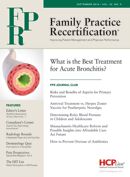Publication
Article
Family Practice Recertification
Overuse of Antibiotics in Respiratory Treatments
Author(s):
A look at the impact on of waiting to prescribe medication for respiratory infections

Frank J. Domino, MD
Review
Title: How to Prevent Overuse of Antibiotics
Delayed antibiotic prescribing strategies for respiratory infections in primary care: pragmatic, factorial, randomized controlled trial
Molly Wolf, M.D. and Frank J. Domino, M.D.
Citation: BMJ 2014;348:g1606 doi: 10.1136/bmj.g1606
Summary : Delaying prescriptions lowers Unnecessary Antibiotic use
Patient Demographics:
Patients deemed eligible were ages 3 and over, presenting to health professional (MD or NP) with respiratory tract infection diagnosed (acute cold, influenza, sore threat, otitis media, sinusitis, croup, or lower respiratory tract infection).
A total of 889 patients were recruited between March 2010 and March 2012. Of these, 333 were prescribed immediate antibiotics and 556 entered the randomized trial. The group prescribed immediate antibiotic were judged to have slightly more severe symptoms at baseline. Baseline characteristics of the groups were otherwise similar.
Exclusion criteria included active asthma (unless the patient had history of tolerating ibuprofen or aspirin), active or previous peptic ulcers, hypersensitivity to analgesics, those requiring hospital admission, had a known immune deficiency, were pregnant or breastfeeding, or unable to complete outcome measures.
Methods:
Design: this randomized controlled trial set out to examine different strategies of delayed antibiotic usage, while controlling for baseline symptomatic control advice, with a method to identify those who might require immediate antibiotics.
Patients diagnosed by their healthcare providers with “acute respiratory tract infection” and were 3 years of age or older were included in the study. Those judged to require immediate antibiotics were prescribed such.
Patients judged not to require immediate antibiotics were randomized into four strategies of delayed prescription. These methods include recontacting the clinic to request prescription by phone (recontact), post-dating the prescription (post-date), allowing patients to collect the prescription from the clinic themselves (collection), and giving
prescriptions to patients and asking them to wait (patient led).
Each group was then randomized with symptomatic advice. This randomization included antipyretic regiments, (ibuprofen, paracetamol, or both combined), regular antipyretic versus “as required” dosing, and steam inhalation advice versus no advice to inhale with steam. A fifth group, of no antibiotic therapy, was added partway through the trial. All patients given a 2-week symptom diary and all were followed for a minimum of one month and were re-contacted to return diary if it was not returned within a reasonable time frame.
Results and Outcomes:
Primary outcome symptom severity was measured on day of illness 2-4. Symptoms including generally feeling unwell, sleep disturbance, and fever among others were evaluated with a previously validated scale and were rated with 0 meaning it was no problem for the patient or 6 for the worst possible rating.
Secondary outcomes included comparisons to immediate antibiotic use, any antibiotic use in the 14 days after recruitment, side effects like rash, diarrhea, vomiting, or abdominal pain, mean temperature readings, duration of symptoms rated “moderately bad” or “worse”, return with new or worsening symptoms or complication of intervention, and belief in the effectiveness of antibiotics and satisfactions.
Main Results:
Across all groups, there were no significant effects of antibiotic prescribing on symptom severity (P=0.543), duration (P=0.424), or temperature (P=0.176). Duration of symptoms which patients rated moderately bad or worse did not differ between no prescription and delayed prescription (median 3 days vs 4 days, P=0.368).
Examining different strategies within the delayed prescription group, there was no significant effect of antibiotic prescribing on symptom severity (P=0.625) or duration (P=0.368), with small differences of 0.1C in temperature control (P=0.035).
Antibiotic use did not significantly differ between delayed use strategies (P=0.292). About one third of patients with delayed prescriptions used antibiotics, compared to about one fourth of patients not prescribed antibiotics. Overall, use ranged from the lowest of 26% in the no prescription arm, to the highest with 39% in patient led arm.
Belief in the efficacy of antibiotics was not statistically significant between the delayed prescription groups (P=0.805), but was significantly higher in the immediate antibiotic use group (95%, P<0.01) despite the antibiotics having no effect on symptom control or duration of illness.
Complications occurred in 2.5% of patients given no antibiotic prescription, compared with 1.4% in the delayed group, and 2.5% of the immediate group. This was not statistically significant, and there was little difference in other side effects.
Conclusion:
This is the largest published study to directly compare outcomes of symptom control and antibiotic use between several antibiotic prescribing strategies, and also to assess efficacy of different methods to delay antibiotic prescription. Overall, there was little difference in symptom control or complications between the three groups: no prescription, immediate prescription, and delayed prescription. Despite similar outcomes, delayed prescription is likely to be associated with fewer than 40% of patients using antibiotics, compared with 97% usage in the immediate prescription group. The no antibiotic and delayed antibiotic groups were presumably able to avoid poor symptom control because they were given structured symptom advice for using analgesics and steam.
Commentary
Acute respiratory tract infections are among the most common acute conditions seen in primary care. Antibiotic use for these infections is controversial, among physicians, health care providers, and patients. While antibiotic use peaked in the 1990s, concern for over-prescription remains high, largely because of concern for resistance and the development of major infections which may become untreatable.
Delayed prescription for acute respiratory tract infections is recommended internationally, including the current recommendations from the National Institute for Health and Care Excellence. This study is valuable in assessing patient outcomes with different antibiotic regiments, as well as to assess strategies to delay patient use.
These results show similar symptom control, outcomes, and patient satisfaction across the interventions when patients are given structured symptomatic advice. Because the inclusion criteria included diagnosis of “respiratory tract infection”, these results can be broadly applied to practice in primary care offices. Additionally, the study was pragmatic, so patients were free to comply or not comply with the advice given, while still achieving similar outcomes.
A recent Cochrane review (Spurling 2013) found delayed antibiotic use rates around 32% compared to immediate prescription use at 93% and no antibiotic use around 14%. This review also found no different in most symptoms, including fever and malaise, between immediate, delayed, and no antibiotics. Previous studies have found significantly lower patient satisfaction in the delayed prescription strategies, however. A major strength of the current study is providing structured, baseline symptomatic advice (anti pyretic use, inhaled steam, etc.) Such strategies may not only increase patient satisfaction, but help aid patient education on avoiding antibiotic overuse.
Based on these outcomes, providers may feel reasonably confident counseling their patients on delaying antibiotic use. The study is broadly applicable to providers, because they can use any “delayed strategy” they can agree on with each patient. Additionally, providers may consider creating their own structured symptomatic relief information guide, for use of analgesics and steam, to achieve similar symptom outcomes.
About the Author
Frank J. Domino, MD, is Professor and Pre-Doctoral Education Director for the Department of Family Medicine and Community Health at the University of Massachusetts Medical School in Worcester, MA. Domino is Editor-in-Chief of the 5-Minute Clinical Consult series (Lippincott Williams & Wilkins).
Additionally, he is Co-Author and Editor of the Epocrates LAB database, and author and editor to the MedPearls smartphone app. He presents nationally for the American Academy of Family Medicine and serves as the Family Physician Representative to the Harvard Medical School’s Continuing Education Committee.






